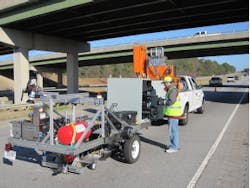Vision system helps fill holes in the road
Engineers at the Georgia Tech Research Institute (GTRI; Atlanta, GA, USA) have developed a vision-based automated pavement crack detection and sealing system. In road tests, the system was able to detect cracks smaller than one-eighth-inch wide and efficiently fill cracks from a vehicle moving at a speed of three miles per hour.
The prototype system, which was mounted on a trailer, consisted of a stereo camera, light-emitting diodes (LEDs), and an assembly that provided a continuous supply of sealant to longitudinal and transverse sealant distribution systems.
As the system travels along a road lane, the LEDs illuminate the road in two directions -- parallel and perpendicular to the road -- and the stereo camera takes two images of the road simultaneously, which are then analyzed using thresholding and filtering algorithms.
Within 100 milliseconds of taking the images, the computer onboard the trailer generates a "crack map" specifying the location and shape of any cracks shown in the images. Based on the cracks found in the image, a controller then instructs sealant applicator valves when to fire.
The researchers tested their crack detection algorithm on more than 100,000 images they collected of cracks on state roads and found the program correctly identified more than 83 percent of the cracks.
However, according to Jonathan Holmes, the GTRI research engineer currently leading the project, the crack detection algorithm will need to be improved before a full-scale system can be successfully implemented by transportation departments.
"Our crack detection algorithm was limited because we used a vision-based system which was confounded by regions of high contrast caused by features other than pavement cracks, including dark stains in the pavement, lane stripes, raised-pavement markers, crack sealant and debris. A full-scale system may require a fusion of multiple imaging sensors, such as a 3-D laser scanning system," Holmes says.
Holmes also suggested changes will be necessary in the way the sealant was supplied to the longitudinal and transverse distribution systems before a full-scale system can be realized.
-- by Dave Wilson, Senior Editor, Vision Systems Design
